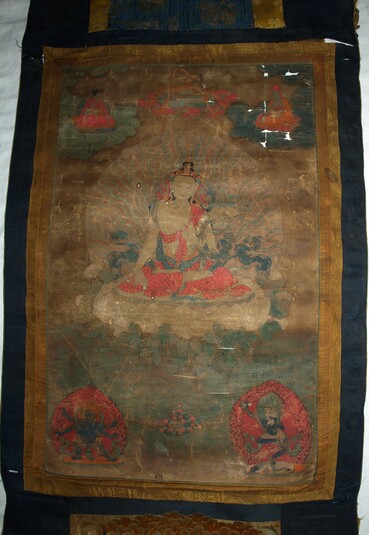
Item: Manjushri (Bodhisattva & Buddhist Deity) - White (Siddhaikavira)
| Origin Location | Tibet |
|---|---|
| Date Range | 1600 - 1699 |
| Lineages | Buddhist |
| Material | Ground Mineral Pigment on Cotton |
| Collection | Private |
Classification: Deity
Appearance: Peaceful
Gender: Male
Manjushri, Sita (Tibetan: jam pal kar po. English: the White One of Glorious Melodious Speech), the bodhisattva of wisdom as a meditational deity, from the Siddhaikavira Mahatantraraja [Toh 544].
This composition is attributed by inscription to the artist Choying Dorje (1604-1674). The subject and style of the painting is also found listed as one of the works of Choying Dorje in the 'karchag' of Nenang Pawo Rinpoche where it states that the artist created an image of White Manjushri in the 'menri' painting style.
Sanskrit: Manjushri Tibetan: Jam pal yang
Tibetan: Jam pal yang
Although there are a number of different forms of Manjushri that have a white appearance generally when referring to a white Manjushri it refers to either the popular Siddhaikavira or the Arapachana - not to be confused with the orange Arapachana.
"...from...an ocean of nectar, white and cool, with many elephants, geese and water fowl sporting and playing, calling out with sweet sounds, in the middle of that...[arises] a lotus with a stem, branches, leaves, fruit and a marvelous sweet fragrance. Above [arises] a moon disc seat with cool rays of light shining forth to the ten directions. Again [the light] collects ... and from this collection ... is Manjushri; white like the autumn moon, a boy of eight years with a youthful form, having five knots [of hair]. The right hand is in the mudra of supreme generosity. The left holds a blue lotus to the heart, blossoming at the left shoulder and marked with the Prajnaparamita book. Seated firmly with the feet in vajra posture, with the major marks and blazing with light, adorned with various jewel ornaments and wearing white silks." (Mati Tradition, Rinchen Gyaltsen, 15th century).
At the top left side is the 9th Karmapa, Wangchug Dorje (1556-1602/03) wearing the traditional black hat. The right hand is raised in a gesture of blessing and the left hand holds a folio book in the lap. A name inscription with Tibetan letters spells the Sanskrit name of Wangchug Dorje> - Guru Athara Vajra.
At the top right side is the Indian teacher Jetari Drale Nampar Gyalwa (950-1000). He is elderly in appearance with light brown skin. A red pandita hat sits atop the head and he wears the orange robes of a monk. The right hand is extended across the knee and the left holds a folio book in the lap. The name inscription is partially written in Sanskrit and partially in Tibetan.
The Siddhaikavira (Solitary Hero) Tantra was first translated into Tibetan in the 11th century at the time of Lord Atisha and is classified as a Kriya or Charya Tantra. It describes numerous forms of Manjushri along with a host of other deities both peaceful and wrathful: Sarasvati, Jambhala, Vasudhara, Achala, etc.
Lineage of Teachers: Lord Manjushri, Acharya Jetari, Maha Pandita Mati, Kashmiri Pandita Shakyashri, Bodhishri, Devashri, Sanggye Zhonnu, Sonam Sherab, Khenchen Sherab Gonpo, Sharchen Yeshe Gyaltsen (Ludingpa), Ngorchen Kunga Zangpo (1382-1456), etc.
Jeff Watt 6-2016
Front of Painting
English Translation of Inscription: [Name inscriptions for the four secondary figures].
Reverse of Painting
English Translation of Inscription: Drawn by the hand of Choying Dorje.
Artist: Choying Dorje (Paintings with Jewels)
Artist: Choying Dorje (Painting)
Painting Tradition: Menri Main Page
Buddhist Deity: Manjushri, White (Masterworks)
Buddhist Deity: Manjushri, White, Main Page
Subject: Artist Index
Buddhist Deity: Manjushri, White (Siddhaikavira Tantra)
Painting Tradition: Menri Deities Page (15/16th Century)







